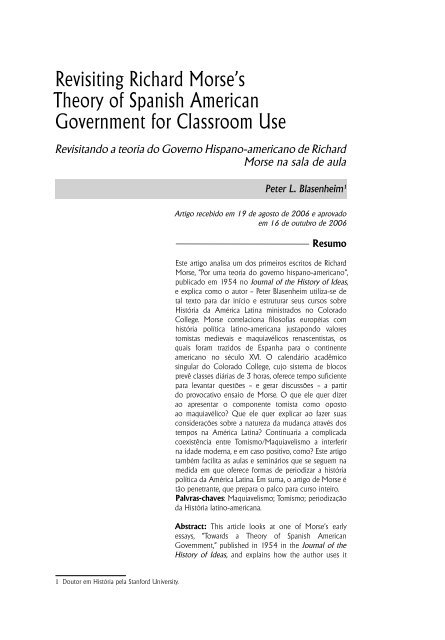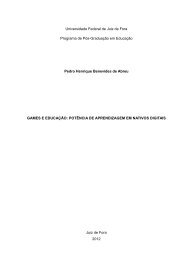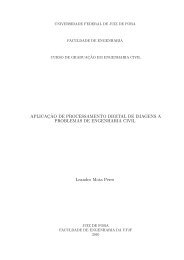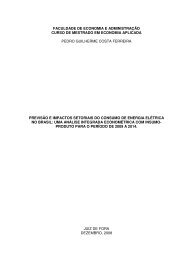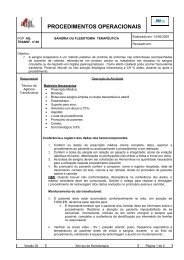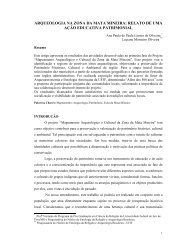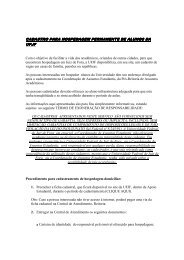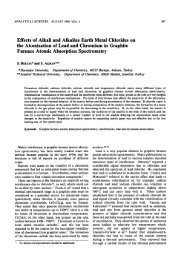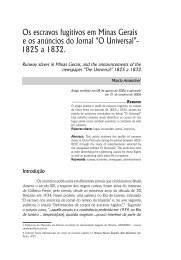Revisiting Richard Morse's Theory of Spanish American Government
Revisiting Richard Morse's Theory of Spanish American Government
Revisiting Richard Morse's Theory of Spanish American Government
Create successful ePaper yourself
Turn your PDF publications into a flip-book with our unique Google optimized e-Paper software.
<strong>Revisiting</strong> <strong>Richard</strong> Morse’s<br />
<strong>Theory</strong> <strong>of</strong> <strong>Spanish</strong> <strong>American</strong><br />
<strong>Government</strong> for Classroom Use<br />
Revisitando a teoria do Governo Hispano-americano de <strong>Richard</strong><br />
Morse na sala de aula<br />
1 Doutor em História pela Stanford University.<br />
Peter L. Blasenheim 1<br />
Artigo recebido em 19 de agosto de 2006 e aprovado<br />
em 16 de outubro de 2006<br />
Resumo<br />
Este artigo analisa um dos primeiros escritos de <strong>Richard</strong><br />
Morse, “Por uma teoria do governo hispano-americano”,<br />
publicado em 1954 no Journal <strong>of</strong> the History <strong>of</strong> Ideas,<br />
e explica como o autor – Peter Blasenheim utiliza-se de<br />
tal texto para dar início e estruturar seus cursos sobre<br />
História da América Latina ministrados no Colorado<br />
College. Morse correlaciona filos<strong>of</strong>ias européias com<br />
história política latino-americana justapondo valores<br />
tomistas medievais e maquiavélicos renascentistas, os<br />
quais foram trazidos de Espanha para o continente<br />
americano no século XVI. O calendário acadêmico<br />
singular do Colorado College, cujo sistema de blocos<br />
prevê classes diárias de 3 horas, <strong>of</strong>erece tempo suficiente<br />
para levantar questões – e gerar discussões – a partir<br />
do provocativo ensaio de Morse. O que ele quer dizer<br />
ao apresentar o componente tomista como oposto<br />
ao maquiavélico? Que ele quer explicar ao fazer suas<br />
considerações sobre a natureza da mudança através dos<br />
tempos na América Latina? Continuaria a complicada<br />
coexistência entre Tomismo/Maquiavelismo a interferir<br />
na idade moderna, e em caso positivo, como? Este artigo<br />
também facilita as aulas e seminários que se seguem na<br />
medida em que <strong>of</strong>erece formas de periodizar a história<br />
política da América Latina. Em suma, o artigo de Morse é<br />
tão penetrante, que prepara o palco para curso inteiro.<br />
Palvras-chaves: Maquiavelismo; Tomismo; periodização<br />
da História latino-americana.<br />
Abstract: This article looks at one <strong>of</strong> Morse’s early<br />
essays, “Towards a <strong>Theory</strong> <strong>of</strong> <strong>Spanish</strong> <strong>American</strong><br />
<strong>Government</strong>,” published in 1954 in the Journal <strong>of</strong> the<br />
History <strong>of</strong> Ideas, and explains how the author uses it<br />
Locus revista de história 2° proS5:89 S5:89 24/1/2008 16:01:24
Peter L.<br />
Blasenheim<br />
Locus<br />
revista de<br />
história,<br />
Juiz de Fora,<br />
v. 12, n. 2,<br />
p. 89-98, 2006<br />
90<br />
to introduce and structure courses taught at Colorado<br />
College on Latin <strong>American</strong> history. Morse correlates<br />
European philosophies with Latin <strong>American</strong> political<br />
history by juxtaposing Thomistic medieval values and<br />
Machiavellian renaissance values, which Spain brought to<br />
the Americas in the sixteenth century. The three-hour<br />
classes provided by Colorado College’s unique academic<br />
calendar, the Block Plan, provides the time to address<br />
the questions raised—and the discussion generated—by<br />
Morse’s provocative essay. What does he mean by the<br />
Thomistic as opposed to the Machiavellian component?<br />
What larger point is he making about the nature <strong>of</strong><br />
change over time in Latin America? Does the Thomistic/<br />
Machiavellian play <strong>of</strong>f continue into the modern age and<br />
if so in what ways? This article also facilitates lectures<br />
because it provides a mean to periodize Latin <strong>American</strong><br />
history. In sum, one trenchant article sets the stage for<br />
an entire course.<br />
Keyword: Machiavellian; Thomistic; periodization <strong>of</strong><br />
Latin <strong>American</strong> History<br />
Pr<strong>of</strong>essor Jeffrey Needell referred to <strong>Richard</strong> Morse as Latin<br />
<strong>American</strong>ists’ “only pensador” 2 in a 2001 obituary published in the Hispanic<br />
<strong>American</strong> Historical Review. I agree with Needell and other historians <strong>of</strong><br />
the region who acknowledge Morse to be one <strong>of</strong> the deepest thinkers in<br />
the field. 3 In particular, his insights into Latin America’s political culture,<br />
expressed in relatively few, well chosen words, are pr<strong>of</strong>ound.<br />
This paper looks at one <strong>of</strong> Morse’s early essays, “Toward a <strong>Theory</strong><br />
<strong>of</strong> <strong>Spanish</strong> <strong>American</strong> <strong>Government</strong>,” first published in 1954 in the Journal <strong>of</strong><br />
the History <strong>of</strong> Ideas, and explains how I use it to introduce and to structure<br />
several courses on Latin <strong>American</strong> history I have been teaching at Colorado<br />
College since the mid-seventies. The article serves two purposes: it provides<br />
students with a theoretical framework for studying change over time in Latin<br />
America and it suggests ways to periodize the region’s history. In short, one<br />
very trenchant essay helps set the stage for an entire course.<br />
In the article, Morse sets out to correlate European philosophies<br />
with <strong>Spanish</strong> <strong>American</strong> political history. To this end, he juxtaposes Thomistic<br />
medieval values and Machiavellian renaissance values, all <strong>of</strong> which were<br />
brought from Spain to the Americas in the sixteenth century. For the first half<br />
century <strong>of</strong> the <strong>Spanish</strong> Empire, Morse argues, “the administration hovered<br />
2 Jeffrey D. Needell, Obituary: <strong>Richard</strong> M. Morse (1922-2001), Hispanic <strong>American</strong> Historical Review, 81:<br />
3/4 (2001), p. 759.<br />
3 The point is made in several book reviews and by scholars who contributed to the conference prepared by<br />
the Oliveira Lima Library in Washington, D.C. entitled “Reflections on Culture and Ideology in the Americas: A<br />
Conference in Honor <strong>of</strong> <strong>Richard</strong> M. Morse.” These essays were published in the Luso-Brasilizan Review, 32/ 2<br />
(Winter, 1995). See also Gerald Martin, “Rev. <strong>of</strong> New World Soundings: Culture and Ideology in the Americas<br />
by <strong>Richard</strong> M. Morse,” Journal <strong>of</strong> Latin <strong>American</strong> Studies, 22/3 (Oct., 1990): 623-24; Mark D. Szuchman, “Rev.<br />
<strong>of</strong> New World Soundings: Culture and Ideology in the Americas by <strong>Richard</strong> M. Morse,” Hispanic <strong>American</strong><br />
Historical Review, 71/4 (Nov. 1991): 869-70.<br />
Locus revista de história 2° proS5:90 S5:90 24/1/2008 16:01:24
etween medieval and Renaissance orientations.” 4 But after Philip II came to<br />
power in 1556, the Empire fell into a predominantly Thomistic mold in which<br />
it remained until independence. Then the “recessive” or latent Machiavellian<br />
traits became dominant in the form <strong>of</strong> the rise <strong>of</strong> the caudillos, Latin America’s<br />
famous and infamous strongman leaders.<br />
Colorado College’s Block Plan, our peculiar academic calendar, which<br />
consists <strong>of</strong> eight three-and-a-half week “blocks” per academic year, fosters<br />
intensive study <strong>of</strong> one subject at a time since students enroll in only one class<br />
each block. This means three hours <strong>of</strong> Morse on Day Two and usually a good<br />
part <strong>of</strong> Day Three <strong>of</strong> a class that meets a total <strong>of</strong> merely eighteen days. At first,<br />
this might seem like an inordinate amount <strong>of</strong> time to devote to one twenty-two<br />
page article but experience has taught me that it pays to take the time to address<br />
the questions raised—and encourage the discussion generated—by Morse.<br />
What exactly does he mean by the Thomistic as opposed to the Machiavellian<br />
component and what are the attributes <strong>of</strong> each? On what grounds does he<br />
consider his explanation <strong>of</strong> political instability and caudillismo “positive” in<br />
contrast with the “negative views” held by other scholars <strong>of</strong> caudillismo? 5<br />
Does the Thomistic/ Machiavellian play-<strong>of</strong>f continue into the twentieth and<br />
even twenty-first centuries and if so in what ways? And what larger point is he<br />
making about the nature <strong>of</strong> change over time in Latin America as opposed to<br />
conventional liberal and even some neo-Marxist notions <strong>of</strong> change, theories<br />
explained in a few other classic sources in the field which we compare with<br />
Morse during the first week <strong>of</strong> the course? 6<br />
I can only suggest answers to these questions, more complicated,<br />
multi-faceted and problematic than they might at first appear. Yet the most<br />
compelling class sessions in my career I owe to the students who have<br />
challenged my opinions and each other’s opinions about what Morse is really<br />
trying to say—sometimes by comparing and contrasting him with those other<br />
historians. The important point is that in the course <strong>of</strong> debate and discussion,<br />
that theoretical framework I refer to above finally emerges by the end <strong>of</strong> class<br />
on that first Thursday—with only two more Thursdays left to the block!<br />
4 <strong>Richard</strong> M. Morse, “Toward a <strong>Theory</strong> <strong>of</strong> <strong>Spanish</strong> <strong>American</strong> <strong>Government</strong>,” Journal <strong>of</strong> the History <strong>of</strong> Ideas,<br />
15 (1954): 74.<br />
5 Morse, “Toward a <strong>Theory</strong>,” 78-79.<br />
6 See, for example, Charles C. Griffin, “The Enlightenment and Latin <strong>American</strong> Independence from A. P.<br />
Whitaker (ed.), Latin America and the Enlightenment (2 nd ed., Ithaca: Cornell University Press, N.Y., 1961):<br />
119-41; Charles C. Griffin, “Economic and Social Aspects <strong>of</strong> the Era <strong>of</strong> <strong>Spanish</strong>-<strong>American</strong> Independence,” The<br />
Hispanic <strong>American</strong> Historical Review, 29 (1949): 170-87; R. A. Humphreys, “The Fall <strong>of</strong> the <strong>Spanish</strong> <strong>American</strong><br />
Empire,” History (October 1952): 213-27 and selections from Leopoldo Zea, The Latin-<strong>American</strong> Mind<br />
(Norman, Ok: University <strong>of</strong> Oklahoma Press, 1963); O. Carlos Stoetzer, The Scholastic Roots <strong>of</strong> the <strong>Spanish</strong><br />
<strong>American</strong> Revolution (New York: Fordham University Press, 1979); Francisco José Moreno, Legitimacy and Stability<br />
in Latin America (New York: New York University Press, 1969); and Stanley J. Stein and Barbara H. Stein,<br />
The Colonial Heritage <strong>of</strong> Latin America, (New York: Oxford University Press, 1970). I also use the section on<br />
independence in Morse’s chapter “The Heritage <strong>of</strong> Latin America,” in Louis Hartz, The Founding <strong>of</strong> New Societies:<br />
Studies in the History <strong>of</strong> the United States, Latin America, South Africa, Canada, and Australia (New York:<br />
Harcourt, Brace and World, 1964): 159-69.<br />
91<br />
<strong>Revisiting</strong><br />
<strong>Richard</strong> Morse’s<br />
<strong>Theory</strong> <strong>of</strong><br />
<strong>Spanish</strong><br />
<strong>American</strong><br />
<strong>Government</strong> for<br />
Classroom Use<br />
Locus:<br />
revista de<br />
história,<br />
Juiz de Fora,<br />
v. 12, n. 2,<br />
p. 89-98, 2006<br />
Locus revista de história 2° proS5:91 S5:91 24/1/2008 16:01:24
Peter L.<br />
Blasenheim Having said that, what does Morse mean by the “Thomistic” as<br />
opposed to the “Machiavellian” mode, reminding my students <strong>of</strong> his supposition<br />
(which I explain to them in the form <strong>of</strong> an admonition) that whenever one<br />
was dominant the other was recessive? Surely, this is not a course on St.<br />
Thomas Aquinas, scholasticism and thirteenth-century Europe nor, for that<br />
matter, on Machiavelli and the amoral statecraft <strong>of</strong> renaissance Europe, topics<br />
well taught by my departmental colleagues. Suffice it to discuss behaviors and<br />
attitudes one might associate with the Thomistic mode—genuinely living up<br />
to one’s obligations towards fellow humans, obligations determined by one’s<br />
station in life and based upon principles <strong>of</strong> Christian justice—contrasted with<br />
the “sheer personal verve and cunning” 7 we associate with Machiavelli and<br />
attributes we Latin <strong>American</strong>ists are always busy ascribing to conquistadors<br />
and caudillos.<br />
That there’s something inherently Thomistic and Machiavellian about<br />
Latin <strong>American</strong> civilization is a concept some <strong>of</strong> my students find difficult to<br />
grasp and <strong>of</strong>ten they don’t like it even when they do. Perhaps this is because<br />
they’re more Lockean than they realize. Sometimes they challenge it on the<br />
basis <strong>of</strong> its apparent elitism, the value system <strong>of</strong> the dominating class brought<br />
over from Spain. I counsel patience. Compare it with other ways <strong>of</strong> looking<br />
at Latin America that we will be discussing tomorrow, I tell them, and then<br />
challenge it. For the puzzled student, asking the class for good synonyms for<br />
“Thomistic” and “Machiavellian” <strong>of</strong>ten helps. Morse associated the Thomistic<br />
mode with Queen Isabella and the Machiavellian with King Ferdinand. What<br />
about Don Quixote and Sancho Panza…or Ideal and Real? And for the student<br />
who is still confused and/or unconvinced—please don’t fret—all Morse means<br />
is that the more dominant the Thomistic component, the more the system is<br />
working the way it ought to really work; the more dominant the Machiavellian,<br />
the more the system is a free for all…but with the caveat, <strong>of</strong> course, that power<br />
contenders are pursuing their selfish interests in the name <strong>of</strong> the king.<br />
Indeed this is the time to segue into some essential and very<br />
compelling attributes <strong>of</strong> Latin <strong>American</strong> political culture, attributes which even<br />
well educated Anglo-<strong>American</strong>s with little knowledge <strong>of</strong> the region could<br />
better understand in light <strong>of</strong> Morse. As just suggested, the colonial practice<br />
<strong>of</strong> reaffirming allegiance to the Crown while breaking the law—let’s call it the<br />
obedezco pero no cumplo (I obey but do not comply) or the ¡Muera el mal<br />
gobierno…viva el rey! (Death to the government…Long live the King!) formula<br />
we all studied in our first encounter with colonial Latin <strong>American</strong> history—makes<br />
so much sense when seen from the perspective <strong>of</strong> the Machiavellian mode.<br />
So do its post-independence manifestations, the overthrow <strong>of</strong> a caudillo or<br />
a Constitution in the name <strong>of</strong> a “republican” version <strong>of</strong> a “higher” law, that is,<br />
Locus<br />
revista de<br />
história,<br />
Juiz de Fora,<br />
v. 12, n. 2,<br />
p. 89-98, 2006<br />
92<br />
an even more popular, charismatic caudillo or another idealistic (Thomistic?)<br />
Constitution.<br />
7 Morse, “Toward a <strong>Theory</strong>,” 73.<br />
Locus revista de história 2° proS5:92 S5:92 24/1/2008 16:01:25
So this is what Morse means when he challenges the “somewhat<br />
negative view” that “attribute[s] <strong>Spanish</strong> <strong>American</strong> instability to the imposition<br />
<strong>of</strong> French-, British- and <strong>American</strong>-type constitutions upon peoples whose<br />
illiteracy, poverty, provincialism, political inexperience and social inequalities<br />
rendered ineffectual the mechanisms <strong>of</strong> constitutional democracy.” 8 His<br />
“positive” explanation, let’s call it his thesis even though it comes seven<br />
pages into the article, holds that in Latin America the Enlightenment and<br />
political independence simply triggered the Machiavellian component. In<br />
other words, asking if Latin <strong>American</strong> nations are “prepared” for constitutional<br />
democracy is not the appropriate question. It makes no sense to consider<br />
what the Enlightenment and political independence did not achieve. Latin<br />
<strong>American</strong>s are neither politically backward nor corrupt. Rather, much like<br />
Anglo-<strong>American</strong>s, they’re the products <strong>of</strong> their own history.<br />
And if indeed caudillos and constitutions are effective to the degree<br />
that they restore what Morse, citing Weber, calls “the authority <strong>of</strong> the eternal<br />
yesterday,” 9 what point is he making about the nature <strong>of</strong> change over time<br />
in Latin America? Does all change occur to prevent change? Is there a<br />
tremendous difference between what Latin <strong>American</strong>s have chosen to say for<br />
the last two hundred years...and what they have meant? Have they in fact only<br />
been “groping to recover and legitimize an overarching patrimonial state,” that<br />
is, what Morse calls the “clandestine” force at work? 10<br />
On the other hand, as good historians, shouldn’t we be relying<br />
on evidence rather than clandestine forces to prove our points? And Latin<br />
America has changed over time. There are the classical articles by Charles<br />
Griffin who argues that the Enlightenment and the independence movements<br />
might not have sparked genuine revolutions but that they did set the stage for<br />
evolutionary change in the region. And then there are (or were) the dependistas<br />
who insist that the decisive stimulus to change is always external. 11 Perhaps<br />
Morse is flawed. Perhaps his argument is elitest…and deterministic. Let’s not<br />
confuse twentieth or twenty-first century Latin America with medieval Spain.<br />
Perhaps. In fact, I try to keep my own opinions out <strong>of</strong> our debates.<br />
But however valid the criticism <strong>of</strong> Toward a <strong>Theory</strong> <strong>of</strong> <strong>Spanish</strong> <strong>American</strong><br />
<strong>Government</strong>, Morse does an extraordinary job <strong>of</strong> assessing change over time<br />
from a strictly Latin Ameican perspective. As a student and scholar <strong>of</strong> Latin<br />
America, I appreciate what he has done.<br />
And speaking as a teacher <strong>of</strong> Latin <strong>American</strong> history, I’m also<br />
grateful. This is because by that first Thursday, thanks to many hours <strong>of</strong> Morse<br />
and an hour or two <strong>of</strong> a half dozen other historians, 12 some who tend to<br />
8 Morse, “Toward a <strong>Theory</strong>,” 78.<br />
9 Morse, “Toward a <strong>Theory</strong>,” 87.<br />
10 Morse, “The Heritage <strong>of</strong> Latin America,” 169.<br />
11 See the two articles by Griffin cited above in note 4; Stein and Stein, 109.<br />
12 See note 4, above.<br />
93<br />
<strong>Revisiting</strong><br />
<strong>Richard</strong> Morse’s<br />
<strong>Theory</strong> <strong>of</strong><br />
<strong>Spanish</strong><br />
<strong>American</strong><br />
<strong>Government</strong> for<br />
Classroom Use<br />
Locus:<br />
revista de<br />
história,<br />
Juiz de Fora,<br />
v. 12, n. 2,<br />
p. 89-98, 2006<br />
Locus revista de história 2° proS5:93 S5:93 24/1/2008 16:01:25
Peter L.<br />
Blasenheim<br />
Locus<br />
revista de<br />
história,<br />
Juiz de Fora,<br />
v. 12, n. 2,<br />
p. 89-98, 2006<br />
94<br />
sympathize with his ideas and others who don’t, most <strong>of</strong> my students have<br />
some theoretical foundation for studying Latin <strong>American</strong> history; and they<br />
have the tools to evaluate the sources they will be reading and the lectures<br />
they will be attending for the rest <strong>of</strong> the block.<br />
As teacher, I also find the article an effective tool for periodizing Latin<br />
<strong>American</strong> history, a point I made above and the subject <strong>of</strong> the remaining pages<br />
in this essay. Morse suggests a timeline that students can visualize with a very<br />
simple diagram depicting the shifting structure <strong>of</strong> the Empire, hovering between<br />
Thomistic and Machiavellian orientations in the first half century <strong>of</strong> the Empire<br />
but predominantly Thomistic from the accession <strong>of</strong> Philip II in 1556 until the<br />
Napoleonic invasion released the latent, recessive Machiavellian tendencies<br />
kept in check by the Crown since the mid-sixteenth century. What I do is turn<br />
up the power <strong>of</strong> the microscope on this timeline, sometimes refining it, always<br />
expanding and developing it and usually taking some liberties with it. Beyond<br />
providing students with an outline <strong>of</strong> Latin <strong>American</strong> history, this also gives me<br />
the opportunity to introduce them to the terms they will be hearing repeatedly<br />
in the days ahead. And it provides a way <strong>of</strong> illustrating some <strong>of</strong> the difficult<br />
concepts that have already been introduced.<br />
Let’s start in 1474, the year <strong>of</strong> Isabella’s accession to the throne, rather<br />
than 1504, the year <strong>of</strong> her death, because to understand the mindset and,<br />
thereby, the reign <strong>of</strong> this most Thomistic <strong>of</strong> monarchs it must be understood that<br />
she inherited Castile from her half-brother, the allegedly incompetent Henry IV<br />
whose nobles, according to the chroniclers, ran roughshod over their lord. 13<br />
Isabella, Morse’s “Thomistic” monarch, brought this “Machiavellian” situation<br />
back into some sort <strong>of</strong> equilibrium, restraining her nobles and increasing the<br />
real authority <strong>of</strong> the Castilian state. But even Isabella, the Thomistic ruler par<br />
excellence, was “recessively” Machiavellian. We see this after the appearance<br />
<strong>of</strong> Columbus when the queen, who had labored so assiduously to increase<br />
her power, gave some <strong>of</strong> it away as part <strong>of</strong> her deal with the Admiral <strong>of</strong> the<br />
Ocean Sea. And yet what the queen gave away, the queen had the right to<br />
take back. As she (and Morse) remind us, as early as 1493 she asked by what<br />
authority the Admiral had enslaved her new Amerindian vassals. 14 What a<br />
good illustration <strong>of</strong> the system’s Thomistic underpinnings even though the<br />
queen was behaving in such Machiavellian fashion.<br />
So much for Isabella and Ferdinand, the Trastámara period. Now let’s<br />
look at the reign <strong>of</strong> the first Hapsburg monarch, Charles V, and the Age <strong>of</strong> the<br />
Conquest or the Encounter. Recall that Morse said the system hovered between<br />
the Thomistic and Machiavellian modes during this period. Yet surely if we<br />
zoom in and examine the first chaotic decades <strong>of</strong> the sixteenth century—let’s<br />
say from 1492 to 1542, when the New Laws made an attempt to restrict the<br />
13 Ramón Menéndez Pidal, “The Significance <strong>of</strong> the Reign <strong>of</strong> Isabella the Catholic,” in Roger Highfield (ed.),<br />
Spain in the fifteenth Century (New York: Harper & Row, 1972), 380-86.<br />
14 Morse, “Toward a <strong>Theory</strong>,” 73.<br />
Locus revista de história 2° proS5:94 S5:94 24/1/2008 16:01:25
powers <strong>of</strong> the conquistadores and their heirs—the orientation <strong>of</strong> the <strong>Spanish</strong><br />
New World, to use Morse’s language, was predominantly Machiavellian. To<br />
illustrate this, let’s draw a line back from the Thomistic to the Machiavellian<br />
side <strong>of</strong> the chalkboard and write in the year “1542” just below where we<br />
began in 1474. After all, the conquistadors got their repartimientos and<br />
their encomiendas, slaves in the Machiavellian “Real” if not the Thomistic<br />
“Ideal,” during these years. After all, Charles V reversed decisions to restrict<br />
encomienda to encourage the Machiavellian designs <strong>of</strong> his conquistadors and,<br />
consequently, his own wealth and influence.<br />
But with enough power, the Crown could take control back from<br />
the conquistadors and their heirs…or at least try…as it did by promulgating the<br />
New Laws which restricted encomienda, that is, elite control over Amerindian<br />
labor, at first in theory and then gradually in fact. The system was moving back<br />
into the Thomistic mode, which it did definitively after Philip II came to the<br />
throne in 1556. Of course, it remained recessively Machiavellian. The New<br />
Laws were suspended in response to the defiance <strong>of</strong> the encomenderos, who,<br />
predictably, broke the law in the name <strong>of</strong> the Crown. Suspended but kept on<br />
the books, symptomatic <strong>of</strong> the fact that the <strong>Spanish</strong> state was growing stronger,<br />
as it had under Isabella but now on an imperial scale. Phase Two <strong>of</strong> the<br />
Hapsburgs…the reign <strong>of</strong> Philip II…the height <strong>of</strong> <strong>Spanish</strong> power…predominantly<br />
Thomistic.<br />
Next comes the Century <strong>of</strong> Decline beginning roughly with the<br />
accession <strong>of</strong> Philip III in 1598 and lasting until the outbreak <strong>of</strong> the War <strong>of</strong> the<br />
<strong>Spanish</strong> Succession brought on by the death <strong>of</strong> the childless Charles II in 1700.<br />
The weaker the Empire, the more predominant its Machiavellian tendencies.<br />
Our timeline moves back to the Machiavellian side <strong>of</strong> the chalkboard. Here<br />
we look at the growth and institutionalization <strong>of</strong> the haciendas that enabled<br />
the creole elite to pursue their feudal fantasies, haciendas grudgingly legalized<br />
by an enervated government desperate for revenues. This is when a semilegal<br />
labor system <strong>of</strong> debt peonage replaced encomienda, thus making the<br />
haciendas economically viable. Surely, too, the growth <strong>of</strong> contraband so<br />
characteristic <strong>of</strong> the seventeenth century fits into this “Machiavellian” chapter<br />
<strong>of</strong> the story. As does the practice <strong>of</strong> purchasing <strong>of</strong>fice and even “whiteness” by<br />
economically successful but racially suspect vassals <strong>of</strong> the Crown.<br />
After 1700, the more the Bourbon dynasty strengthened its grip on<br />
Spain and the Empire, the more Thomistic the system became. As for our<br />
diagram, let’s distinguish between the early Bourbon period, say 1700 to 1760,<br />
when our timeline inches back towards the Thomistic side, from the Bourbon<br />
Reforms <strong>of</strong> Charles III and IV, that is, 1760 through 1808, when it starts to<br />
move much more rapidly…all the way back to the far edge <strong>of</strong> the Thomistic<br />
side <strong>of</strong> the chalkboard.<br />
Napoleon invaded and toppled the Bourbon dynasty, the Thomistic<br />
foundation stone that held the system together. This was the event that<br />
95<br />
<strong>Revisiting</strong><br />
<strong>Richard</strong> Morse’s<br />
<strong>Theory</strong> <strong>of</strong><br />
<strong>Spanish</strong><br />
<strong>American</strong><br />
<strong>Government</strong> for<br />
Classroom Use<br />
Locus:<br />
revista de<br />
história,<br />
Juiz de Fora,<br />
v. 12, n. 2,<br />
p. 89-98, 2006<br />
Locus revista de história 2° proS5:95 S5:95 24/1/2008 16:01:25
Peter L.<br />
Blasenheim unleashed caudillismo, the clearest manifestation <strong>of</strong> the Machiavellian<br />
component <strong>of</strong> Latin America’s “dual heritage” 15 and the inspiration for<br />
Morse’s article. As for our diagram, our timeline rushes headlong back to the<br />
Machiavellian side <strong>of</strong> the board.<br />
Now is the time to make some suggestive points about Charles<br />
III’s policies even though the Bourbon Reforms have been introduced solely<br />
for purposes <strong>of</strong> outlining Latin <strong>American</strong> history. Bourbon “liberalism”<br />
really meant progressively tighter government control, less as opposed to<br />
more personal freedom for the creole elite, right? Of course, as I explain<br />
to the class, this all played out in different ways among different groups in<br />
the several Latin <strong>American</strong> viceroyalties and their capitals. But might the<br />
exaggerated Machiavellianism <strong>of</strong> the caudillos have followed inexorably from<br />
the exaggerated Thomism, that is, the tightening up <strong>of</strong> the system, under the<br />
later Bourbons? Perhaps the Bourbons were too successful in making the Real<br />
conform to the Ideal. And they paid for their success. Just food for thought<br />
for the class at the end <strong>of</strong> a taxing three-hour class.<br />
I want my students to decide for themselves how much they want<br />
to talk about the applicability and relevance <strong>of</strong> Thomistic and Machiavellian<br />
attributes when discussing post-independence governance in Latin America<br />
and, for that matter, modern Latin <strong>American</strong> history in general. Predictably,<br />
Morse suggests that the pattern he has described for the colonial system<br />
persists, that is, the political system continues to alternate between the two<br />
orientations, with one dominant and the other recessive. 16 Accounting<br />
always for wide variation among the several Latin <strong>American</strong> nations, by the<br />
middle <strong>of</strong> the nineteenth century, he points out, the system was shifting back<br />
from the Machiavellian to the Thomistic mode in the region’s major countries<br />
thanks to “successful” caudillos who managed to bring peace and even some<br />
economic growth or Lockean constitutions modified to reflect the region’s<br />
cultural reality.<br />
The important point here is that I can extend our outline, <strong>of</strong>ten on<br />
the other side <strong>of</strong> the chalkboard, for courses focusing on the modern period.<br />
Here are a few examples.<br />
Brazil, thanks to the peculiar circumstances <strong>of</strong> its independence<br />
movement, surely remained Thomistic until the fall <strong>of</strong> Pedro II in 1889, with<br />
perhaps a short Machiavellian interlude between the abdication <strong>of</strong> Pedro I<br />
and the Interpretive Law <strong>of</strong> 1840 which recentralized the political system. 17<br />
The Old Republic, famous, even by Brazilian standards, for its backroom deals,<br />
political violence and corruption brings us right back to the Machiavellian<br />
side <strong>of</strong> the diagram. The Age <strong>of</strong> Getúlio takes us back once again to the<br />
Thomistic side…at least until the Second Republic began to unravel in the late<br />
Locus<br />
revista de<br />
história,<br />
Juiz de Fora,<br />
v. 12, n. 2,<br />
p. 89-98, 2006<br />
96<br />
15 Morse, “Toward a <strong>Theory</strong>,” 73.<br />
16 Morse, “Toward a <strong>Theory</strong>,” 85-91.<br />
17 Morse makes this point specifically in “Toward a <strong>Theory</strong>,” 91.<br />
Locus revista de história 2° proS5:96 S5:96 24/1/2008 16:01:25
1950s. I’ll end my outline here, only because the class has neither the time<br />
nor background to begin the always informative and sometimes troubling and<br />
contentious debate regarding placement <strong>of</strong> the Military Republic and the New<br />
Republic.<br />
Doubtless, Morse’s theory also helps illustrate and organize the postindependence<br />
history <strong>of</strong> Chile. Frustrated by the failure <strong>of</strong> a half dozen “exotic”<br />
liberal constitutions foisted on the country by would-be caudillos and mere<br />
politicians (some idealistic and some venal), the “conservative” classes rallied<br />
to the quasi-monarchic presidential system established by businessman Diego<br />
Portales in 1830. Thus did Chile become the first <strong>Spanish</strong> <strong>American</strong> country<br />
to restore some sort <strong>of</strong> Thomistic equilibrium to its politics in the aftermath <strong>of</strong><br />
independence without having to rely on a caudillo. But Chile was outgrowing<br />
the Portalian system by the third quarter <strong>of</strong> the century, in large part because<br />
economic growth, fostered by political stability (paradoxically) revealed and<br />
then exacerbated the shortcomings <strong>of</strong> the ultra-conservative regime. On the<br />
basis <strong>of</strong> a (revived) liberalism, the Chilean elite now insisted upon curbing the<br />
powers <strong>of</strong> the president and did so but at the cost <strong>of</strong> a bloody civil war. In fact,<br />
the Chilean political system was shifting into the Machiavellian mode, a trend<br />
that continued during the “lost” decades <strong>of</strong> the parliamentary period, from<br />
1891 to 1920 when the president <strong>of</strong> Chile was a figurehead and the country<br />
was rudderless. Arturo Alessandri and his successors restored presidentialism,<br />
(the Thomistic system?) now moderated <strong>of</strong> course by a relatively powerful,<br />
democratically elected legislative branch. The Radical presidents <strong>of</strong> the midtwentieth<br />
century, the caudillo Carlos Ibáñez (1952-58), the Conservative<br />
Jorge Alesandri (1958-64), and the Christian Democrat Eduardo Frei (1964-<br />
70) were all heirs <strong>of</strong> this system. But what about the election <strong>of</strong> the Socialist<br />
Salvador Allende in 1970 and the brutal seventeen year dictatorship <strong>of</strong><br />
General Augusto Pinochet who led the coup against Allende in 1973? Don’t<br />
these events challenge Morse’s assumptions and ideas? Perhaps they do…but<br />
maybe they don’t; they might even confirm them.<br />
Modern Argentina also fits into the model, not so neatly, perhaps,<br />
but Argentine history is anything but neat. I choose 1835, the year Rosas<br />
acquired total and unlimited power, to reverse direction and head back from<br />
the Machiavellian and towards the Thomistic side <strong>of</strong> the diagram. With our<br />
hats <strong>of</strong>f to Bartolomé Mitre, the Conciliators and the Oligarchs continued<br />
the trend Rosas started. Just when the system began to short circuit is a<br />
very debatable question, as is the appropriate year to mark a shift back to<br />
a more Thomistic orientation. Some historians, I suspect, would argue that<br />
Argentina has never recovered from the political “fall” <strong>of</strong> the Oligarchy in<br />
1916, in the sense that the country stalled in the Machiavellian mode and has<br />
remained there ever since. Be that as it may, for purposes <strong>of</strong> my course on<br />
modern Argentina, I’m comfortable citing the Sáenz Peña Law <strong>of</strong> 1912 and the<br />
emergence <strong>of</strong> the Radicals as the moment when Argentina’s Machiavellian<br />
characteristics began to come to the fore again, a situation the Concordancia<br />
97<br />
<strong>Revisiting</strong><br />
<strong>Richard</strong> Morse’s<br />
<strong>Theory</strong> <strong>of</strong><br />
<strong>Spanish</strong><br />
<strong>American</strong><br />
<strong>Government</strong> for<br />
Classroom Use<br />
Locus:<br />
revista de<br />
história,<br />
Juiz de Fora,<br />
v. 12, n. 2,<br />
p. 89-98, 2006<br />
Locus revista de história 2° proS5:97 S5:97 24/1/2008 16:01:26
Peter L.<br />
Blasenheim and the golpistas <strong>of</strong> 1943 tried but failed to reverse. I really want to leave<br />
the Peronist heyday, 1946 to 1952, open to debate; as I confess first week,<br />
I expect my students to develop and propose radically different arguments<br />
about what we should do with this relatively short period <strong>of</strong> time…and where<br />
we should place it on our timeline. After Argentina imploded in the mid-<br />
1950s, <strong>of</strong> course, we’re back to (or still in, depending upon what we’ve done<br />
with Perón) the Machiavellian mode.<br />
Finally, there’s Mexico. Surely, we could ascribe some<br />
“recessive” Thomistic characteristics to Mexico in the Age <strong>of</strong> Santa Anna. After<br />
all, he oversaw a few peaceful moments and his links with the “conservative<br />
classes” combined with his charisma made him more legitimate than any other<br />
Mexican chief <strong>of</strong> state in the first half-century <strong>of</strong> Mexican independence. Still,<br />
the Age <strong>of</strong> Santa Anna, and the period that followed, the Age <strong>of</strong> Júarez and<br />
the Reform, clearly illustrate the Machiavellian side <strong>of</strong> Mexican history. It’s<br />
Porfírio Díaz and his cohorts who reversed this trend only to pave the way<br />
for a new Machiavellian phase beginning with the Revolution <strong>of</strong> 1910 and<br />
lasting until 1940 when the revolution became implicitly and then explicitly<br />
“institutionalized,” that is, increasingly Thomistic. Who knows which side <strong>of</strong> the<br />
diagram we should use to describe Mexico since the election <strong>of</strong> Fox in 2000.<br />
It’s much too early to tell.<br />
The first Friday <strong>of</strong> the block is upon us. For colonial<br />
classes, students are learning about pre-Colombian America and the Age<br />
<strong>of</strong> Discovery from various perspectives. For classes in modern Latin America,<br />
they’re studying in some detail the late colonial period in one or the other<br />
<strong>of</strong> the several viceroyalties. Thanks to Morse, they have an outline that helps<br />
them organize and digest the vast amount <strong>of</strong> material they are taking in this<br />
morning from their assigned reading and my lecture, an outline that will serve<br />
them for the rest <strong>of</strong> the block. Thanks to Morse and a few <strong>of</strong> his colleagues<br />
they also have a theoretical framework to help them analyze all this material.<br />
And thanks exclusively to Morse, I say with some assurance, they’ve set aside<br />
many <strong>of</strong> their stereotypes about Latin America and they’re thinking about the<br />
region in entirely new ways. Incidentally, this means they’re thinking about<br />
Anglo-America in new ways too…but that’s a different story.<br />
Locus<br />
revista de<br />
história,<br />
Juiz de Fora,<br />
v. 12, n. 2,<br />
p. 89-98, 2006<br />
98<br />
Locus revista de história 2° proS5:98 S5:98 24/1/2008 16:01:26


